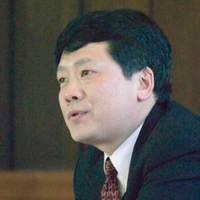
"China and the Re-Centering of East Asia" Special Lecture Series with Brantly Womack
CHINA AND THE RE-CENTERING OF EAST ASIA
A Special Lecture Series
Overview: China’s emergence in this century is historic in two senses. It is currently transforming international relationships, especially in East Asia. Secondly, these developments have deep resonance with the central role of China in the pre-modern era. Understanding future global prospects requires an appreciation of the continuities of East Asian geopolitics as well as the changing structure of current relationships.
The University of Virginia is sponsoring a special series of four lectures by Professor Emeritus Brantly Womack that will present a comprehensive analysis of China’s once and future centrality in East Asia. The lectures will cover: 1. The basic elements of China’s centrality and their evolution in the pre-modern era; 2. The decentering of Asia in the era of Western modernization, putting China on the periphery of the modern globalized world; 3. The reemergence of China as a central modern force in East Asia; 4. The global implications of a China-centered East Asia, including effects on the U.S.-China relationship.
After each lecture there will be a commentary by a distinguished Asian scholar: Wang Gungwu of National University of Singapore; Wu Yushan of Taiwan’s Academia Sinica; Qin Yaqing of Shandong University; and Evelyn Goh of Australian National University. The commentaries will followed by audience Q&A.
The program will occur on successive Thursday evenings starting September 16 from 8:30 p.m. to 10:00 p.m. EST. The first session will be on September 16, the second on September 23, the third September 30, and the final session on October 7. They will be held on Grounds, but they will also be available on Zoom and Youtube Live. The Asia-based commentators will present their remarks on livestream. All are welcome to both the on-Grounds and the Zoom or Youtube Live programs.
Zoom Registration Links
September 16 - Introduction and China’s Premodern Centricity
September 23 - Modernization and the Decentering of Asia
September 30 - Convergence and Asian Recentering
October 7 - China, East Asia, and the Reconfiguration of a Multinodal World

Youtube Live Links
September 16 - Introduction and China's Pre-Modern Centricity (Livestream recording)
September 23 - Modernization and the Decentering of Asia (Livestream recording)
September 30 - Convergence and Asian Recentering
October 7 - China, East Asia, and the Reconfiguration of a Multinodal World
The Idea
This project is a rethinking of the obvious: China was the center of the traditional Sinitic world of East Asia; China was marginalized during the era of Western modernization; in the current era China has returned to a central position in East Asia broadly defined; and the transformation of East Asia has important consequences for the global configuration. But why the discontinuity between the three eras? What linkage is there? What difference does it make for China, for East Asia, and for the world? Is the current fixation on the U.S.-China rivalry too uniformed about history and too narrow in its bipolar focus?
The reason that the obvious begs rethinking is that the depth of current changes in regional and global dynamics requires a reconsideration of the general framework of our perceptions. China is not simply returning to its past glory, nor is it simply becoming the majority stakeholder in existing regional structures. And what is happening in East Asia is increasingly vital to the rest of the world. Despite the grand disjunctions between China’s traditional centrality, its decentering in the modern era, and its present increasingly central role, are there underlying factors of continuity? What is the salience of the different characteristics of each era?
The key mysteries are those of the resilience of China’s centrality in the pre-modern era, the loss of that resilience during Western modernization, and its return in the global present. Culture and power, though important, are inadequate explanations. Rather, three more basic structural realities underlie traditional China’s resilience, its marginalization, and its current return. They are its presence, its population, and its production. These have changed drastically in salience over the three eras, and China’s current integration with East Asia is producing a complex and major node of global reality. The cohesiveness of the node will depend on whether China can be credible in its respect for the autonomy of its neighbors.
Since this is a study of relationships, special attention will be paid to the transformations of connectivity among the three eras. The traditional era was characterized by thin connectivity. Connectivity is necessarily thinner given the agrarian subsistence and transportation of the era, but just as important was China’s prioritization of maintaining official control of the relationship rather than expanding contact. By the Ming dynasty this had evolved into the tribute system, a mechanism for managing disparities of interests and perceptions. East Asia’s geopolitics was characterized by resilient asymmetry centered on China rather than international conquest or balance among presumptive equals. But even well-managed asymmetry involves quite different exposures and perceptions between center and localities.
Western powers came to East Asia with sharp connectivity. Colonization and the Western presence more generally was intensely focused on global profit and ownership. Sharp connectivity fractured Asia and targeted its productivity toward distant global service. By 1880 China was no longer the primary concern of any of its neighbors. China became a non-presence except as a target of opportunity, and as a non-colony its population and production were largely irrelevant. China became confused periphery of an Asia directed elsewhere.
The return of China’s centrality was a complex process, and the pre-reform period 1949 to 1980 played a foundational role. Nevertheless, until the unfolding of the era of reform and openness no one would have thought of China as central to East Asia—except, perhaps, as a problem. Then the era of thick connectivity began to emerge, first within China itself as marketization, urbanization, and transportation developed, and then externally through the cumulative momentum of its economy and trade. The domestic priority of maximum growth metastasized since 2008 into a general drive toward massive, multidimensional international contact. A modern, unitary, and globally enmeshed China became a central presence to its neighbors. Its population became the most organized one-fifth of the global market, and the scale of its production transformed the global economy, most intensely in East Asia. As in the pre-reform era, the neighbors’ vulnerability to China gives them a more jaundiced view of China’s success, and China has yet to demonstrate a credible acknowledgement of their autonomy.
China’s rise and integration into its region are leading parts of a general reshaping of global reality in this century. Although global media tends to focus on China as a national actor in tension with the United States, the general success of East Asia and its matrix of asymmetric relationships suggest a different paradigm for the global political economy. Rather than a bipolar hegemon-challenger model, a pattern has emerged in which the negotiated management of disparities creates a multinodal web of asymmetric relationships. States are aligned by partnerships rather than by alliances because their task of securing a variety of international prospects becomes more pressing than that of defending against a specific enemy. However, regardless of China’s new centrality to East Asia, the region is not united around China, and the prerequisite of smooth regional functioning is global inclusivity.
The dynamics of East Asia are not the only major current of this century. More generally, the faster relative growth of productivity in the developing world increases the weight of demographic power vis-à-vis the wealth power of the developed world. Meanwhile, the COVID pandemic as well as global warming highlight the general challenges of ecological sustainability. But in these new venues of cooperation and conflict the shape and mass of East Asia will be increasingly important.
The Participants
A broad analytic narrative benefits from different perspectives, and this series includes instant “peer reviews” by some of Asia’s leading scholars. The questions to be addressed are larger than any one answer, and the views of the discussants will open new fields of discussion.
Lecturer

Brantly Womack is Professor Emeritus of Politics at the University of Virginia and Senior Faculty Fellow at the Miller Center. His interest in the general dynamics of Chinese domestic development and international relationships has led to a number of books including Asymmetry and International Relationships, China among Unequals, China’s Rise in Historical Perspective, and China and Vietnam: The Politics of Asymmetry. Most recently his research has focused on China’s re-emergence and its implications.
Discussants

Session 1: Wang Gungwu is a legendary historian of China and of its external relationships. He began his studies with research on the evolving structure of power between the Tang and Song dynasties, and his later research encompassed the Chinese diaspora, and the linkage of traditional and contemporary notions of China’s role. His recent autobiography, Home is Not Here, relates his personal experience growing up as an overseas Chinese in Southeast Asia, and another recent work is China Reconnects: Joining a Deep-rooted Past to a New World Order. Wang is the founding director of the East Asia Institute of National University of Singapore and University Professor there. Before moving to Singapore he was Vice-Chancellor of Hong Kong University, and before that Director of Australian National University’s Research School of Asian and Pacific Studies.

Session 2: Wu Yu-Shan is Academician and Distinguished Research Fellow of Taiwan’s Academia Sinica and founding director of its Institute of Political Science, as well as professor of political science at National Taiwan University. He is a leading scholar on comparative political development in Asian politics, European communism, and cross-Strait politics. Recent books include The Chinese Models of Development: Global, Local and Comparative Perspectives and Resurgence of China: A Dialogue Between History and International Relations (in Chinese).

Session 3: Qin Yaqing is emeritus President of China Foreign Affairs University, Chancellor of the Diplomatic Academy, and one of China’s pre-eminent theorists of international relationships. He is a member of the Foreign Policy Advisory Group of Chinese Ministry of Foreign Affairs. Qin translated Wendt’s Social Theory of International Politics into Chinese. His book, A Relational Theory of International Politics, was published by Princeton in 2018. Qin is particularly interested in the globalization of international relations theory.

Session 4: Evelyn Goh is the Shedden Professor of Strategic Policy Studies and Director of Research at the Strategic and Defence Studies Centre at Australian National University. She is a leading expert on the changing political and diplomatic contours of East Asia. Her work on the hedging strategies of China’s neighbors is well known. Goh recently co-authored with Barry Buzan Re-thinking Sino-Japanese Alienation: History Problems and Historical Opportunities, and current projects include 'Strategic Diplomacy' for the 21st Century.
Moderators

Session 1: Ambassador Stephen Mull is UVA’s Vice Provost for Global Affairs. Before coming to UVA he was Undersecretary of State for Political Affairs, and ambassador to Poland and to Lithuania. Under President Obama Mull was lead coordinator of Iran nuclear implementation. He holds the rank of Career Ambassador.

Session 2: Harry Harding is University Professor at UVA and founding dean of the Batten School. He is also a Yushan scholar at National Chengchi University in Taipei, and before that a visiting professor at Hong Kong University of Science and Technology. He is the author of several classic works on China’s domestic and international politics, including China's Second Revolution: Reform After Mao and A Fragile Relationship: The United States and China Since 1972. He is currently completing work on the evolution of American China policy from the Clinton Administration to the Trump Administration.

Session 3: Leonard Schoppa is Professor of Politics at UVA and an expert on Japan, China’s most diffident neighbor. He is the author of Bargaining with Japan: What American pressure can and cannot do, Education reform in Japan: A case of immobilist politics, and Race for the Exits, and is currently working on the politics of aging societies.

Session 4: Amitav Acharya is the UNESCO Chair in Transnational Challenges and Governance and Distinguished Professor at the School of International Service, American University. He is the first non-Western scholar to be elected President of the International Studies Association. His recent books include The Making of Global International Relations (with Barry Buzan), Constructing Global Order, and The End of American World Order. In 2020, he received American University’s highest honor: Scholar-Teacher of the Year Award.
Sponsors
The primary sponsor is the East Asia Center. Co-sponsors are: The Miller Center, UVA Global, and the Politics Department.